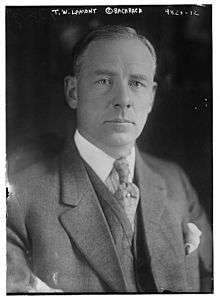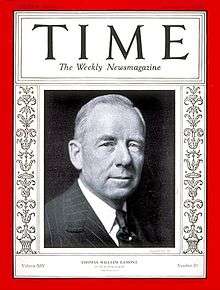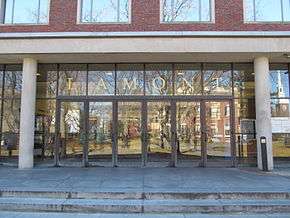Thomas W. Lamont
| Thomas W. Lamont | |
|---|---|
 Lamont circa 1918 | |
| Born |
Thomas William Lamont, Jr. September 30, 1870 Claverack, New York |
| Died |
February 2, 1948 (aged 77) Boca Grande, Florida |
| Education |
Phillips Exeter Academy Harvard University |
| Occupation | Banker |
| Years active | 1903-1947 |
| Employer | J.P. Morgan & Co. |
| Net worth |
$25 million (1948) $261 million (2018 dollars) |
| Board member of | International Committee of Bankers on Mexico |
| Spouse(s) | Florence Haskell (Corliss) Lamont |
| Children | Corliss Lamont, Thomas Stilwell Lamont |

Thomas William Lamont, Jr. (September 30, 1870 – February 2, 1948) was an American banker.
Early life
Lamont was born in Claverack, New York. His parents were Thomas Lamont, a Methodist minister, and Caroline Deuel Jayne. Since his father was a minister, they moved around Upstate New York a lot and they were not very wealthy.[1] He graduated from Phillips Exeter Academy in 1888, where he was editor of the school newspaper, The Exonian, as well as the school yearbook and literary magazine. He then attended Harvard.[1]
Early career
At Harvard College, he became first freshman editor of The Harvard Crimson, which helped him pay off some of his tuition. He graduated cum laude with a Bachelor of Arts degree in 1892. He met his wife, Florence Haskell Corliss, at the 1890 Harvard commencement. He started working under the city editor for the New York Tribune two days after he graduated from Harvard in 1892.[2] He married Florence on October 31, 1895 in Englewood, New Jersey.
He also worked for the Albany Evening Journal, Boston Advertiser, Boston Herald, and New York Tribune, which paid only $25, while he was at Harvard.
At the Tribune, he received many promotions, including night editor and helping the financial editor, which gave him his first taste of the financial world. He left journalism because of the low pay and went into business[1]
He began working in business for Cushman Bros., which later became Lamont, Corliss, and Company, and turned it into a successful importing and marketing firm. It was an advertising agency that worked for food corporations. The company was in a bad financial status, but Lamont fixed it, and the company changed its name to Lamont, Corliss, and Company. He was partners with his brother-in-law, Corliss. His banking caught the attention of banker Henry P. Davison, who asked Thomas to join the new Bankers' Trust. He started as secretary and treasurer and then moved up to being Vice President and then was promoted to director. He rose to the vice presidency of the First National Bank.[1]
He was a member of the Jekyll Island Club on Jekyll Island, Georgia. There, along with J. P. Morgan Jr. and a few others, they secretly made a plan in 1910 there for a central bank, similar to the Federal Reserve System.
In 1918, he purchased the New York Evening Post, of which his brother, Hammond, had been managing editor a decade earlier, from Oswald Garrison Villard. After failing to make a profit, he sold the paper in January, 1922 to a syndicate that was headed by the paper's editor, Edwin F. Gay.
J. P. Morgan
On January 1, 1911, he became a partner of J.P. Morgan & Co., following Davison to the company.[2]
World War I
The company had also started an improvised system so that the Allies could buy supplies from them. In 1917, he joined the Liberty Loan Committee, which helped the treasury sell war bonds to Americans. He also served unofficially as an advisor to a mission to the Allies, led by Edward M. House, as requested by President Woodrow Wilson.[3]
Lamont not only advised the other countries but also went to them. Right before he was going to go to Europe, the Bolsheviks took power in Russia. He and the head of the American Red Cross, William B. Thompson, along with the approval of the British prime minister, Lloyd George, tried to convince America to aid the Bolsheviks so that Russia would stay in the war. However, they were unsuccessful.
Peace negotiations
Both he and Norman H. Davis were appointed as representatives of the Treasury Department to the Paris Peace Conference and had to determine what Germany had to pay in reparations. He drew up the Dawes Plan and the Young Plan to reduce the amount paid by Germany.
Influence
In the interwar period, he was a spokesman for J.P. Morgan because J.P. Morgan Jr. was retiring. He handled the press and defended the firm during hearings like the those of Arsene Pujo that investigated powerful Wall Street bankers.[1]
He was one of the most important agents for the Morgan investments abroad. A member of the Council of Foreign Relations, he was an unofficial advisor to the Wilson, Herbert Hoover, and Franklin Roosevelt administrations.[2]
Japan
Lamont later undertook a semiofficial mission to Japan in 1920 to protect American financial issues in Asia. However, he did not aggressively challenge Japanese efforts to build a sphere of influence in Manchuria;[4] indeed, he supported Japan's non-militaristic politics until late into the 1930s.
Ron Chernow won the National Book Award for his book The House of Morgan in which he claimed that Lamont had authored the infamous Japanese response to deceive the world about the Mukden incident, which was used as a pretext for Japan's invasion of Manchuria. That defied the expressed position of US government and the League of Nations of Japan, not China, being the aggressor.
Mexico
Lamont was the chairman of the International Committee of Bankers on Mexico for which he successfully negotiated the De la Huerta-Lamont Treaty. He continued to chair the committee into the 1940s by a series of renegotiations of Mexico's foreign debt.
Italy
In 1926, Lamont, self-described as "something like a missionary" for Italian fascism,[5] secured a $100 million loan for Benito Mussolini.[5] Despite his early support, Lamont believed the Second Italo-Abyssinian War was outrageous.[2]
On September 20, 1940, the fascist police shocked Lamont by arresting Giovanni Fummi, J.P. Morgan & Co.'s leading representative in Italy.[2] Lamont worked to secure Fummi's release. Fummi was released on October 1 and went to Switzerland.
Wall Street Crash
On Black Thursday in 1929, Lamont was acting head of J.P. Morgan & Co. In an attempt to stop the panic, he organized Wall Street firms to inject confidence back into the stock market through massive purchases of blue chip stocks.
Chairman
Following the reorganization of J.P. Morgan & Co. in 1943, Lamont was elected chairman of the board of directors, after Morgan Jr. died.
Death
Lamont died in Boca Grande, Florida, in 1948.
Charitable work
Lamont became a generous benefactor of Harvard and Exeter once he had amassed a fortune, notably by funding the building of Lamont Library. At the end of World War II, Lamont made a very substantial donation toward restoring Canterbury Cathedral in England. His widow, Florence Haskell Corliss donated Torrey Cliff, their weekend residence overlooking the Hudson River in Palisades, New York, to Columbia University. It is now the site of the Lamont-Doherty Earth Observatory.
Upon Florence's death, a bequest established the Lamont Poetry Prize.

Personal life
His son, Corliss, was a philosophy professor at Columbia University and an avowed socialist. Another son, Thomas Stilwell Lamont, was later vice-chairman of Morgan Guaranty Trust and a fellow of the Harvard Corporation.[6]
A grandson, Lansing Lamont, was a reporter with Time Magazine from 1961 to 1974. He published several books,[7] including You Must Remember This: A Reporter’s Odyssey from Camelot to Glasnost about his experiences covering the important events of the time, including the assassination of Robert Kennedy. Another grandson, Thomas William Lamont II, served in the submarine service on the USS Snook (SS-279) and died when the submarine sank in April 1945.
A great-grandson, Ned Lamont, was the Democratic nominee for U.S. Senate from Connecticut in 2006.
In popular culture
Lamont is a major character in Nomi Prins' novel Black Tuesday (2011) and in Kit Holland's Soul Slip Peak (2013).
Works
- Henry P. Davison; the record of a useful life Harper & Brothers, New York and London, 1933.
- My boyhood in a parsonage, some brief sketches of American life toward the close of the last century Harper & Brothers, New York and London, 1946.
- Across world frontiers, Harcort Brace & Co., New York, 1951.
References
- 1 2 3 4 5 Goldfarb, Stephen. "Lamont, Thomas William". American National Biography Online. Retrieved 6 November 2013.
- 1 2 3 4 5 Lamont, Edward M. (1994). The Ambassador from Wall Street: The Story of Thomas W. Lamont, J.P. Morgan's Chief Executive. Lanham, MD: Madison Books. ISBN 9781568330181.
- ↑ Goldfarb, Stephan. "Lamont, Thomas William". American National Biography Online. Retrieved 6 November 2013.
- ↑ "Banker as Diplomat". Unc.edu. Retrieved 2012-07-26.
- 1 2 "Morgan - Facing the Corporate Roots of American Fascism". Coat.ncf.ca. Retrieved 2012-07-26.
- ↑ "T. S. Lamont 2d And Bobbi Silber Exchange Vows". The New York Times. June 19, 1988. Retrieved 2006-08-10.
- ↑ Ingham, John N. Biographical Dictionary of American Business Leaders. Greenwood Press, Westport CT, 1983. pgs 750-753.
Further reading
- Lamont, Edward M. The Ambassador from Wall Street. The Story of Thomas W. Lamont, J.P. Morgan's Chief Executive. A Biography. Lanham MD: Madison Books, 1994.
- Lundberg, Ferdinand. America's Sixty Families. New York: Vanguard Press, 1937.
- Thomas Lamont Papers at Baker Library Special Collections, Harvard Business School.